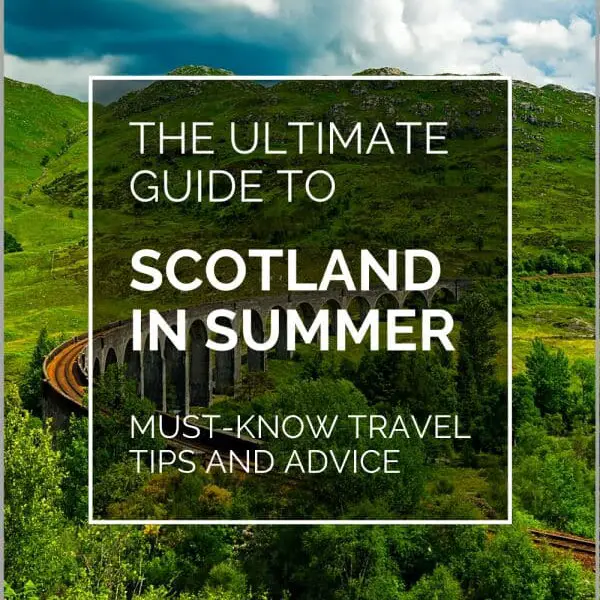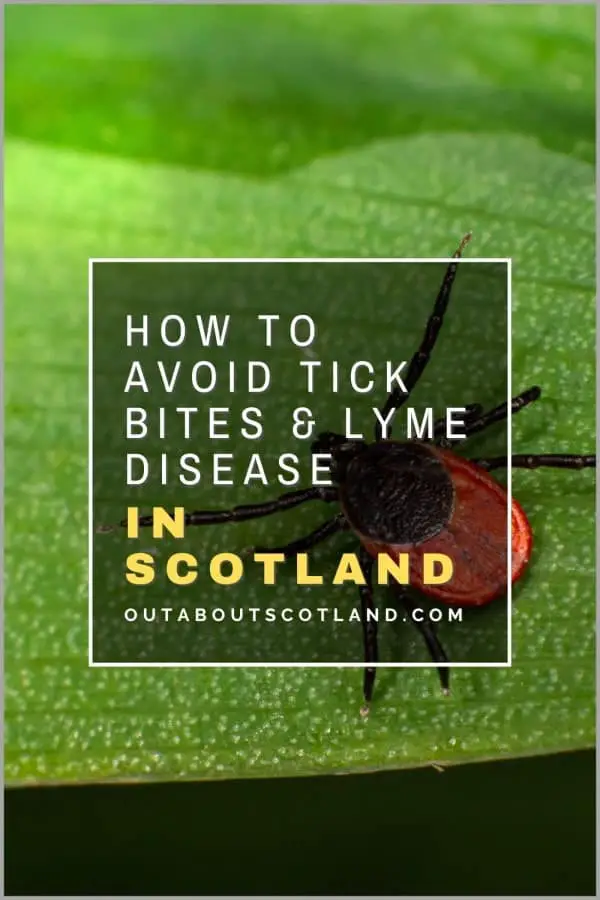Scotland’s high latitude means it gets long daylight hours in summer, with July seeing the sunrise and sunset from around 5 a.m. to 10 p.m. From June to July, average temperatures are between 15°C and 17°C. Discover a collection of travel tips for a summer holiday in Scotland with this article, which includes information about how to avoid midges, the best ways to tour Scotland, facts about the weather, and advice for packing.
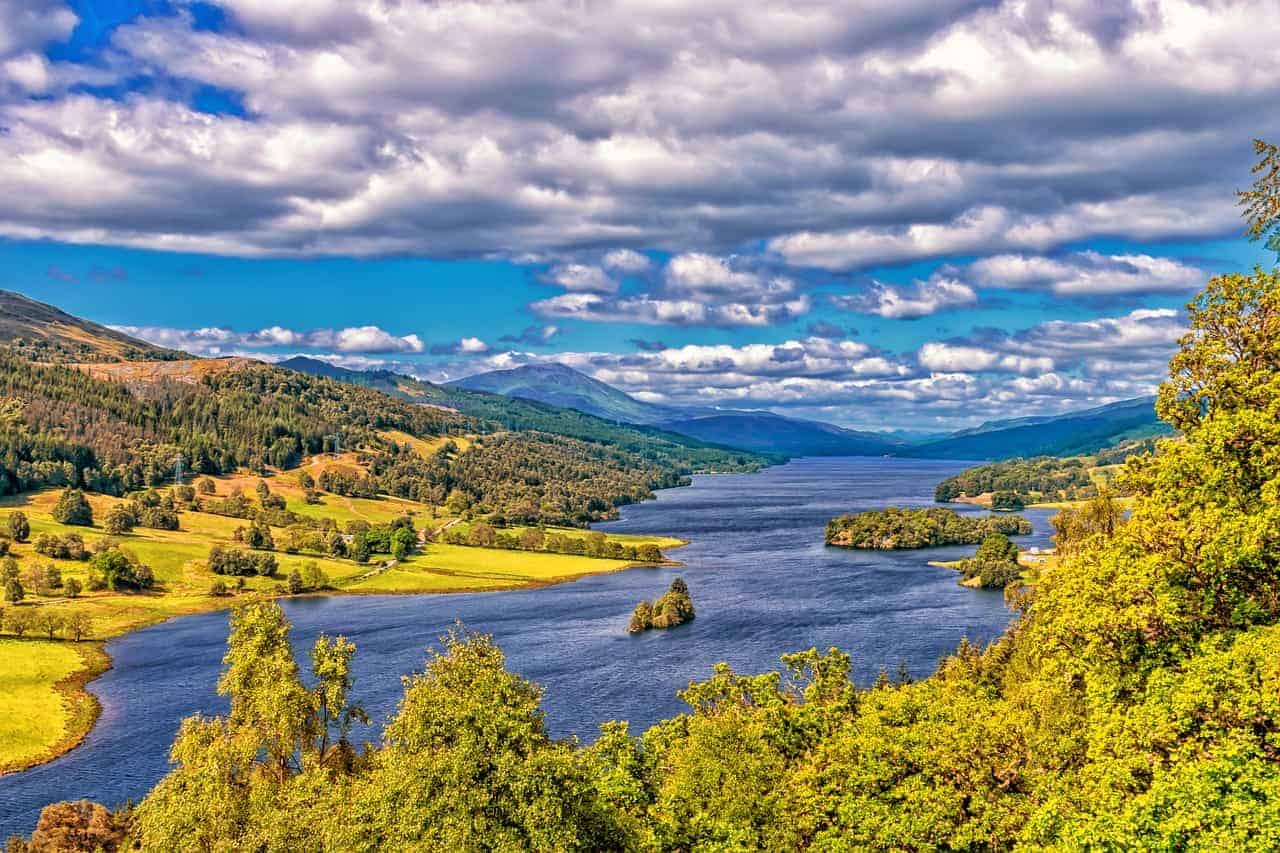
Scotland’s Summertime Weather
Have you ever heard the saying ‘four seasons in one day’? Well, that more or less sums up what you can expect from a Scottish summer thanks to the unpredictable climate that seems to go out of its way to mess with the sightseeing plans of our tourists.
Scotland’s summer months are June, July and August, although historically May and September offer good weather with temperatures a couple of degrees cooler but with less rainfall.
Bear in mind though, this varies wildly depending on whether you’re visiting the north or south of the country, and some years will go to extremes of good or bad weather. Take 2020 as an example. According to World Weather Online the far-south Scottish Borders town of Kelso had a bleak 27 rainy days in August while the far-north town of Wick had 30 days of wet weather.
That’s almost the entire month of Scotland’s mid-summer when it tipped it down. That’s good news for ducks, bad news for the rest of us.
As far as the amount of rainfall goes, it varies day by day, so don’t be surprised to see a mixture of light showers and heavy downpours within a few hours of each other on some days, especially in the Western Highlands, which is officially one of the wettest places in Europe.
Due to the mountainous coastline, humid air is pushed north to produce an average of 4,577mm of rainfall annually, compared to just 870mm in Eastern Scotland.
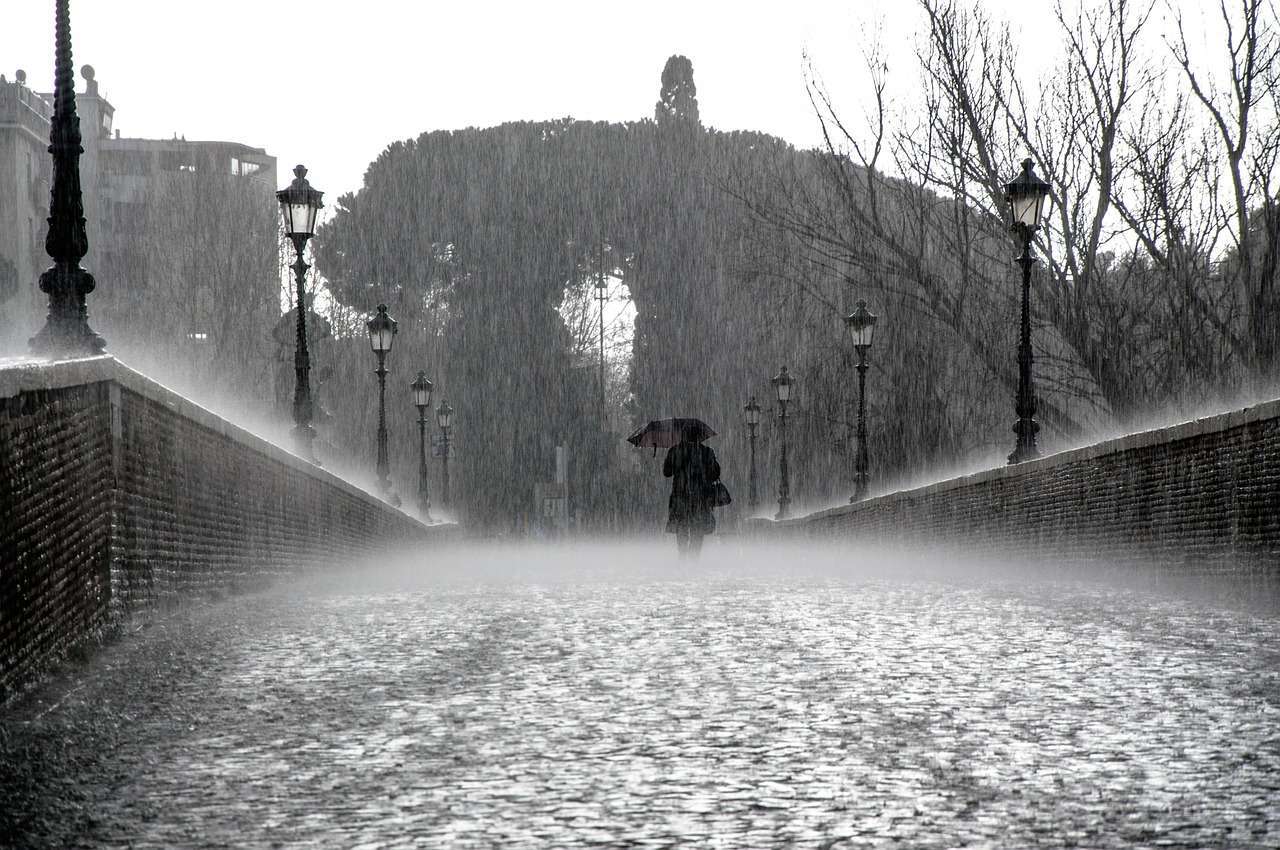
But before you go and cancel your Scottish holiday let me jump in and tell you it’s not always like that. As a rule, you can expect decent weather between the start of June and the end of August where average maximum temperatures sit in the 15°C (59°F) to 17°C (63 °F) region, especially on the east coast which is protected from the frequent storms brought in by the Atlantic Ocean.
That’s why I always suggest spending as much time in Edinburgh and the southeast as possible if you’re travelling here for a once-in-a-lifetime holiday, and it’s why I wrote a Guide to the Best Places to Visit in East Lothian as it’s one of the driest regions in the country. An example of this was in 2019 when there was a very unusual heatwave in Edinburgh and The Lothians that saw temperatures shoot up to 30°C before cooling back down with a few impressive thunderstorms.
Between June and August, you can expect half of the days to be cloudy, while the other half will have clear skies. It’s impossible to state exactly what the weather in Scotland will do in summer but this table will give you a rough guide to what you can expect. Data is from timeanddate.com.
| Weather averages in July | High Temp | Low Temp | Rainfall | Wind |
| Edinburgh | 19 °C | 11 °C | 41.4mm | 8 mph |
| Glasgow | 19 °C | 11 °C | 39.2mm | 8 mph |
| Gretna Green (The Borders) | 19 °C | 13 °C | 54.9mm | 9 mph |
| Braemar (Cairngorms, Highland) | 13 °C | 7 °C | 5.9 mm | 16 mph |
| Thurso (far north) | 16 °C | 8 °C | 35.7 mm | 12 mph |
| Isle of Skye | 17 °C | 11 °C | 76 mm | 9 mph |
Summer Daylight Hours in Scotland
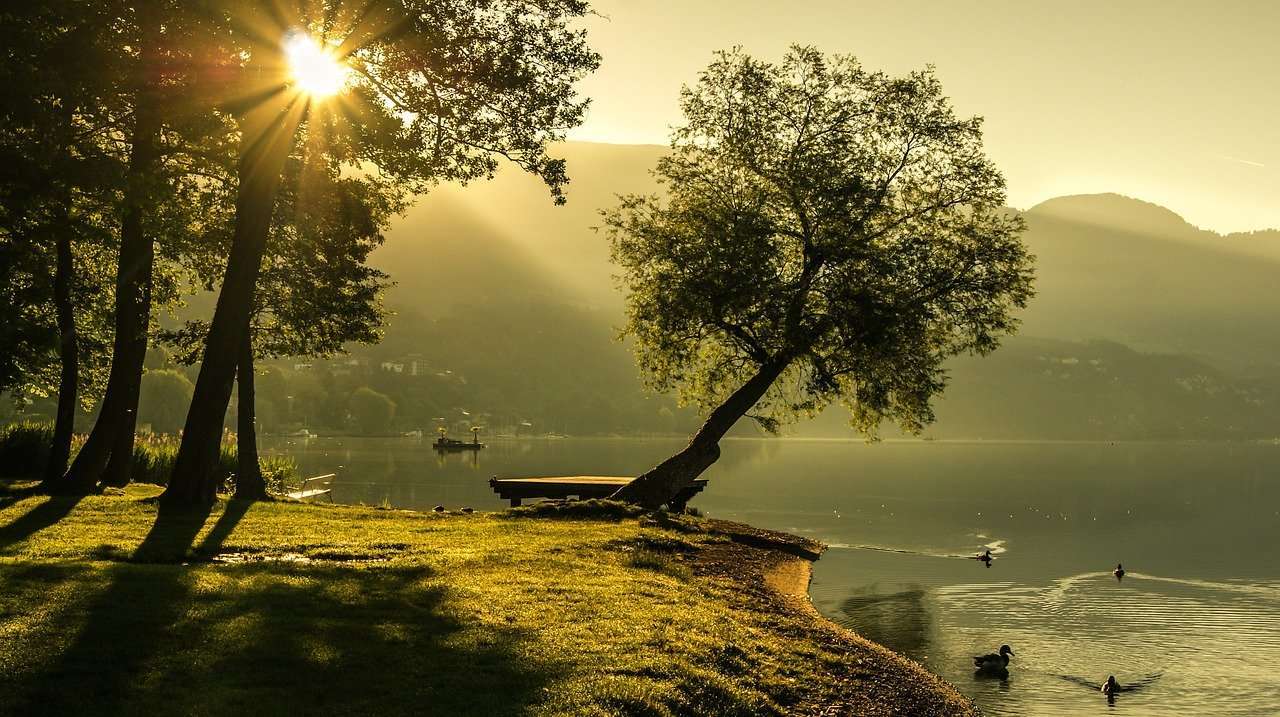
Scotland’s high latitude means we get extremes of daylight hours in winter and summer, with January not seeing full light until around 9 am before it disappears again at 4 p.m. and July seeing sunrise and sunset at 5 am and 10 p.m. – a 10 hour difference.
If you head to the far north of Scotland to somewhere like the Shetland Islands you’ll find yourself enjoying a full 4 hours more daylight than someone who’s chosen to spend their holiday in London, which makes a big difference if you’re intent on enjoying the great outdoors.
In fact, once you get that far north there isn’t any actual complete darkness in summer so be prepared for sleepless nights unless you’ve purchased a sleep mask (Amazon link to the one I have). You’ll find these tables of average daylight hours in Central Scotland will help you plan your itineraries while you’re here, but I recommend checking the Time and Date website for more accurate times for your location.
| June 1st | June 15th | June 30th | |
| Sunrise: Sunset: Daylight Hours: | 04:55 22:11 17 hrs, 26 min | 04:49 21:57 17 hrs, 8 min | 04:40 22:10 17 hrs, 30 min |
| July 1st | July 15th | July 31st | |
| Sunrise: Sunset: Daylight Hours: | 04:46 22:11 17 hrs, 25 min | 05:02 21:59 16 hrs, 57 min | 05:29 21:33 16 hrs, 4 min |
| August 1st | August 15th | August 31st | |
| Sunrise: Sunset: Daylight Hours: | 05:31 21:31 16 hrs, 0 min | 05:57 21:01 15 hrs, 4 min | 06:27 20:21 13 hrs, 54 min |
What to Pack and What to Wear for a Scottish Summer
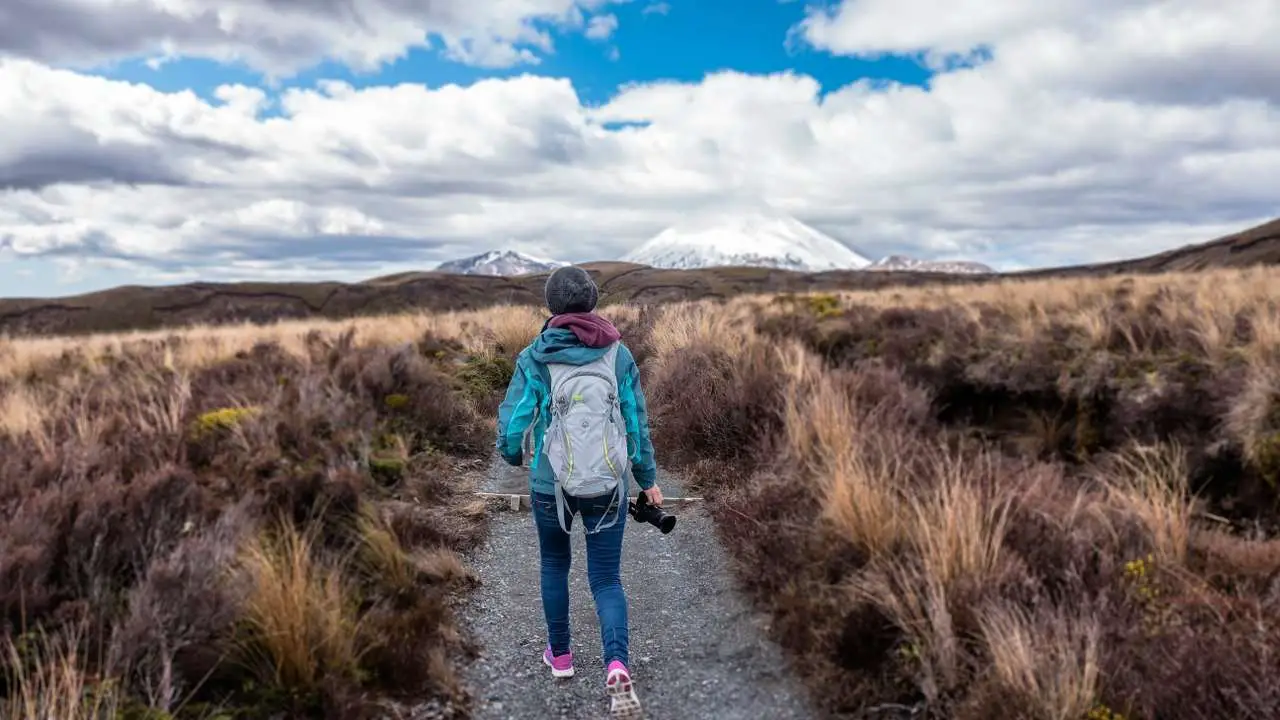
It’s impossible to plan for the weather in Scotland, which is why we have another phrase you need to remember: ‘There’s no such thing as bad weather, only bad clothes’. No matter where you travel in Scotland in summer, there are a few essentials you need to pack before you leave home, whether you’re heading to the bustling metropolis of Edinburgh or you’ve got a 2-week break arranged in the desolate wilderness of the Orkney Islands.
A city break to a cosmopolitan city like Edinburgh or Glasgow doesn’t mean you need to pull your muddy hiking boots on each day (which is great news if you’re a naturally snappy dresser), but if you’re a visiting tourist I recommend taking a few essentials with you no matter your final destination.
The following links are for Amazon.
For starters, take a small backpack and pack it with a few essentials (see the list below) that include additional waterproof and warm clothing like a pac-a-mac and a fleece top. Remember to charge your mobile phone, chuck a portable power pack in your bag for emergencies, and always have a bottle of water with you.
Clothes-wise, start with shorts or thin trousers and wear a base-layer top, ideally something lightweight that wicks away moisture. Stick a pair of lightweight walking shoes on your feet – yes even in the city (I’ll explain why later) – but make sure they’ve got ankle support if you’re exploring anywhere with rough paths.
I’ll list a few more options below for what I think are packing essentials for a summer break in Scotland, all of which I’ve either used myself or know someone who’s recommended them.
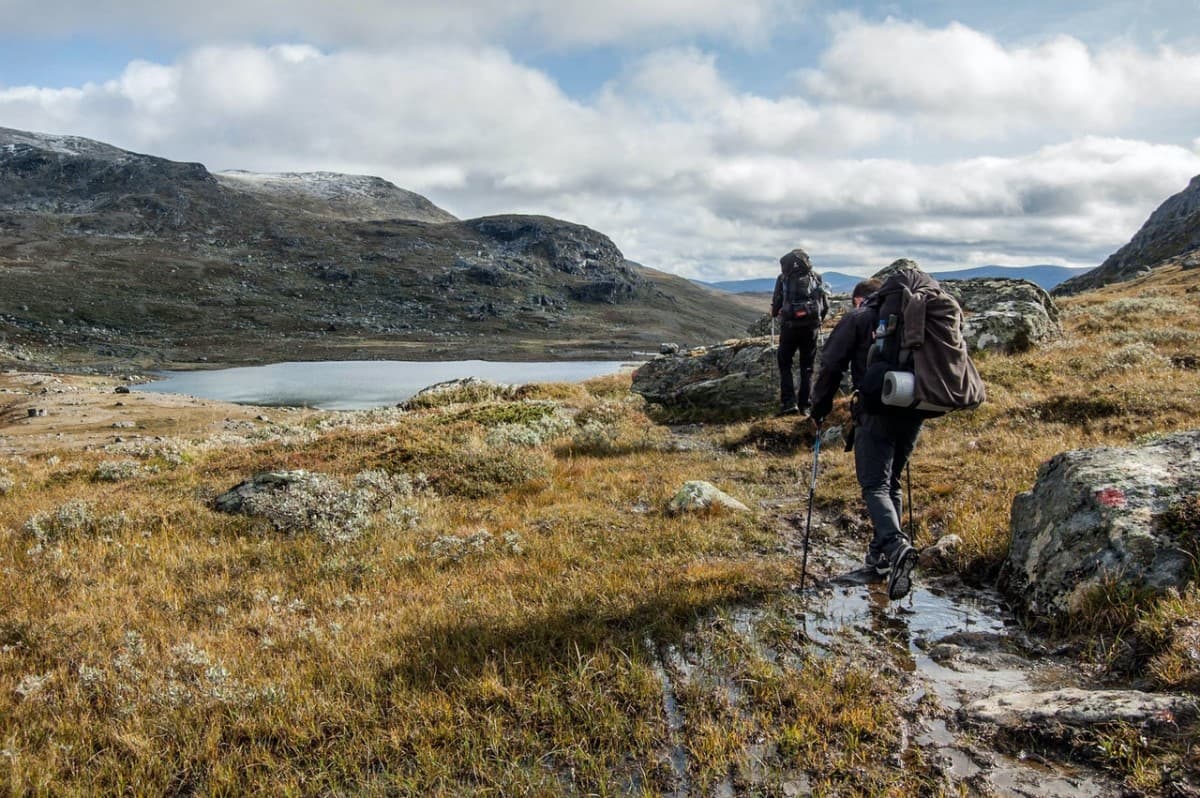
Packing for the City
- Pacamac. These things are unbelievably useful and I’ve lost count of the number of times I’ve grabbed mine from my backpack when the heavens suddenly opened. They also keep the wind out which is useful for when you head to the coast or go hill walking.
- Lightweight walking shoes. I’ve always found that walking in the city is just as tiring as walking in the great outdoors, mainly because you’ll clock up miles and miles as you go around all those attractions spread across the city. Get a pair of shoes that are comfy, lightweight, keep your feet cool, and are at least slightly fashionable.
- Backpack. An utterly invaluable piece of tourist kit. If you’re day-tripping you need something sturdy but light and cheap enough to replace after getting dumped on the ground a thousand times over. See my guide to recommended lightweight backpacks.
- Sunglasses. Yes, I know I said it’s often cloudy but we do get the occasional day here where it’s sunny too. Your choice of frame is a personal preference but I like the ones in the link as they’re decent quality and cheap (I always lose mine so hate paying too much for them).
- Water bottle. Not much to say – it carries water – but the one I’ve linked is strong and leakproof with an easy-to-remove screw-top lid.
Packing for the Outdoors
If you’re heading into the wilderness for your Scottish summer holiday I recommend getting the items listed above for the city, but also add these must-haves for the great outdoors.
- Insect repellant. Pack this in your bag and you’ll probably want to hug me once you get caught in a swarm of Scotland’s infamous midges. This spray does a great job of keeping the little blighters at bay and saves you from having to wear a net hat (which to be fair does a really good job of keeping midges off your face). See my guide to the best midge repellents to use in Scotland.
- Sunscreen. This is a necessity as even on cloudy days you can still get burnt. I like this one by Ambre Solaire as it isn’t too greasy.
- Powerpack. Another essential when you’re in the wilderness as it’ll enable you to recharge your phone when there’s no power socket nearby, which could be a lifesaver if you need to make an emergency call.
- Sleep mask. This is a necessity for when you get further north, especially if you’re sleeping in a tent when sunlight comes streaming through the fabric in the early hours of the morning.
Summer in Scotland Midges – Advice and Tips
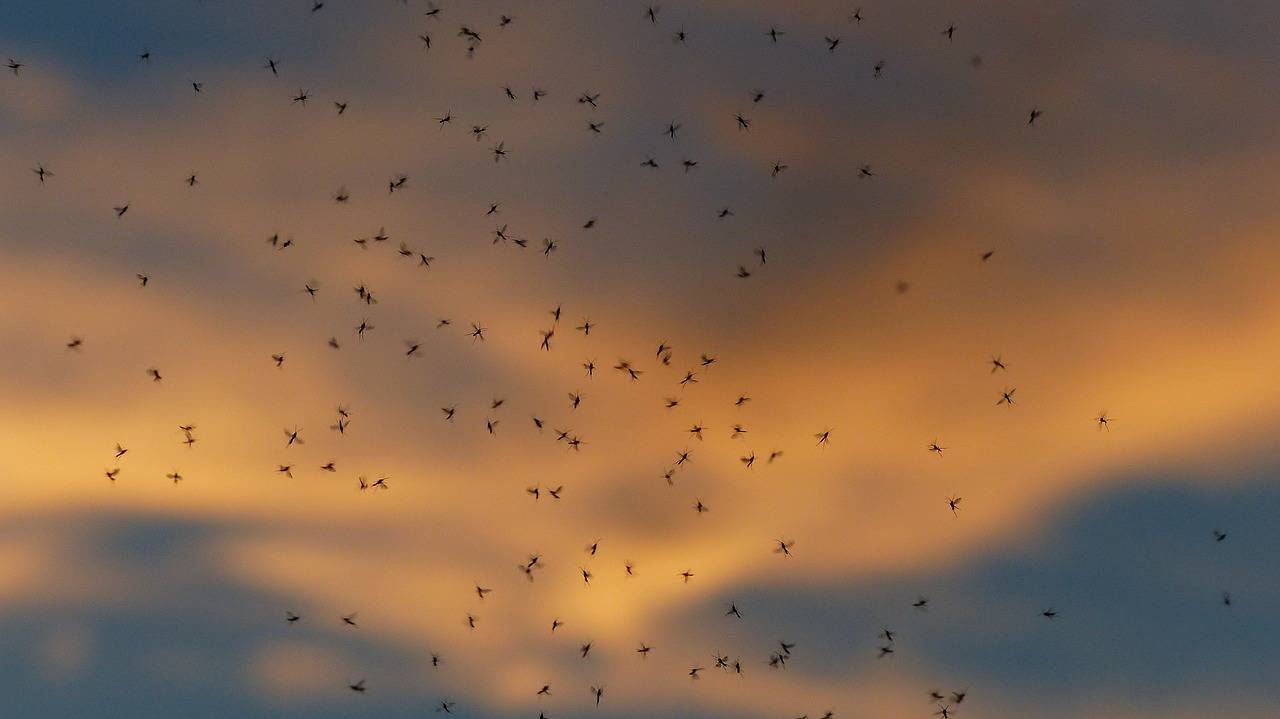
The Highland midge is the evil nemesis of Scotland’s hikers and they’ve caused countless miserable trips to the west coast during the warmer months. These unpleasant little blighters (or should that be biters?…) are a species of small flying insect mainly found in Scotland’s northwest regions from late spring to late summer.
They’re not very big at just a few mm in length but they pack a punch when it comes to their bite, and you can feel the tell-tale pin-prick of their presence whenever you venture anywhere that’s humid and wet, especially on a cloudy day.
While their bite is mildly painful it’s the resulting bumps that drive most people to distraction as they’re impossibly itchy, and if you get just a few of them on your body they’ll make you feel instantly miserable. These bites will last for a couple of days for most people and they can break open quite easily if they’re scratched too hard (with a very real risk of infection), so unless you’ve got a tube of after-bite ointment you’re going to have to put up with that itch for quite some time.
- Best selling bite and sting brand
- Triple action against pain, itching and inflammation
- Relief from insect bites, insect stings and stinging nettles
- Suitable for adults and children over 2 years
- Packaging May Vary
It’s actually only the female midges that bite and you’ll frequently see them forming in huge clouds that are pretty much impossible to escape from, though there are a couple of tips I can give you that will help reduce the impact these little sh*#s can have on your holiday.
First off, try to avoid going anywhere where there’s still water at dawn and dusk as that’s the time and environment where midges are most prevalent (early morning loch-side strolls are asking for trouble). They can bite at any time of the day but you’re less likely to see them from late morning till early afternoon so you might consider exploring the wilds during those hours.
Of course, you’re not going to be able to escape them if you’re camping as they’ll quite happily invade your tent, but if you’ve decided to book into a hotel you should be pretty much midge-free as they don’t like going anywhere where there’s air conditioning.
Because they form in massive clouds they can become unbearable if your head is exposed and they seem to especially like getting into your hair and ears, which is why some people like to wear those hats with the nets that I mentioned earlier.
That’s certainly one option, but I prefer to cover up my body with convertible lightweight hiking trousers for my legs and a thin base layer shirt for my top half and then use plenty of anti-midge spray around my head. The trousers have zip-off bottoms that turn into shorts when it gets warmer later in the day and the base layer sleeves can be rolled up so it’s almost like wearing a T-shirt.
How to Travel Around Scotland in Summer
One bonus of travelling around Scotland in summer is that failing an impromptu earthquake or a meteorite dropping out of the sky, Mother Nature shouldn’t have too much of an impact on your progress. While winter journeys can be plagued by flash floods, snowstorms and hazardous sheets of ice on the roads, conditions in summer are usually pretty good whether you intend to travel by train, car, bus or on foot.
I’ll list a few useful snippets of information that might help you decide on your preferred form of transport below.
Travelling by Bus in Scotland

Using the bus is spectacularly easy in our cities as despite what you might have heard elsewhere our public transport systems are pretty damn good.
Both the main cities of Edinburgh and Glasgow have excellent bus networks, with Glasgow being serviced by First Bus and Edinburgh using Lothian Buses. These services are low-cost and frequent – especially so for Lothian Buses as their vehicles are all in superb condition and you can get a day ticket that’ll give you unlimited hop-on/hop-off transport for around £5.
Glasgow’s First Buses aren’t quite as nice and can be …interesting… at night, but if you stick to travelling during the day you’ll find the service is ultra-efficient and day tickets can be had for around £5.
One little travel hack I have for you is to consider using a tour bus for the entire day if you’re already thinking about booking one for a wee sightseeing trip. Instead of doing your tour, getting off, and then spending the rest of the day using local buses, keep your tour bus ticket and hop on and off whenever you see one circling the main attractions.
They usually just drive between the main attractions all day long and the driver will let you off if you ask, saving you the cost of getting an additional local bus company ticket in the process.
If you want to get between cities on the cheap, then travelling by coach is by far the cheapest option, and you can frequently get special offers for inter-city travel for just a few pounds, so regularly check the Megabus website to see if they’ve got any deals going.
An alternative to Megabus is Citylink Gold which has a fleet of luxury coaches that are just a few pounds more expensive than Megabus, but they include onboard WiFi, complimentary snacks and drinks, and much comfier seats. The service has daily express links between Glasgow, Edinburgh, Aberdeen and Inverness.
Travelling by Car in Scotland
If you’re staying in the city, don’t even bother with a car, as you simply won’t need it, but travelling into the Highlands or anywhere else in Scotland’s countryside is a different matter entirely. In fact, I’d go so far as to say a car is a necessity if you’re planning on going off the beaten path, and this country is practically begging you to get a rental car and go driving (if you absolutely must ditch the car, I’ve written a guide about Travelling Around Scotland Without a Car).
We have lots of beautiful scenic routes to enjoy like the famous North Coast 500, but you’ll need to remember a few key points if you’re going to drive yourself around.
- Britain’s fuel prices are some of the highest in Europe at approximately £1.30 for a litre of petrol and £1.35 for a litre of diesel. A standard small car like a Ford Fiesta will cost £50-£60 to fill up and give you around 500 miles of driving – worth keeping in mind if you’re planning a 2-week road trip.
- British hire car companies love to hard-sell additional insurance add-ons like collision waiver damage. Do your research before talking to the salesman and don’t be afraid to walk away.
- If you’re driving in the remote parts of the Highlands you’ll find garages can be few and far between. Make sure you top up regularly. I always try to find a petrol station before my levels get to 1/4 of a tank.
- It’s illegal to hold a phone while driving so get yourself a dash-mounted phone holder (see below). They’re ultra-handy when using your phone as a sat-nav.
- We’ve got a near-zero alcohol limit when driving. Don’t risk it, even if you think you’re in the middle of nowhere. If you’ve had a drink, get someone else to take the wheel – unless they’ve had a drink too of course.
Travelling by Train in Scotland
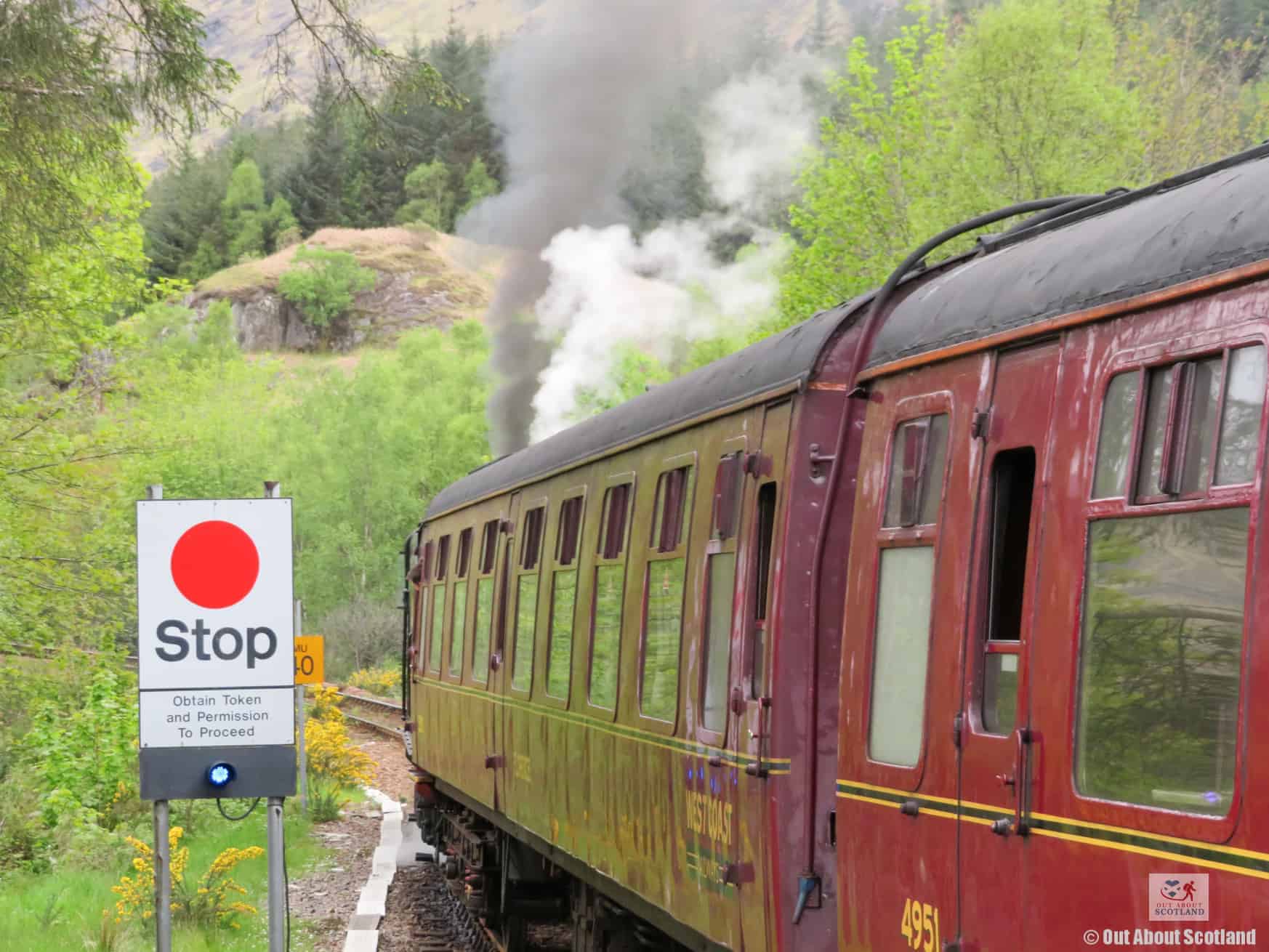
I have to admit, even with all the delays and rip-off ticket prices I really love travelling in Scotland by train. There’s something incredibly romantic about watching mountains, lochs and forests woosh past while you’re sat looking out the window of a train carriage. They’re convenient too, with stations right in the middle of most towns and cities and regular services that run several times a day between the main tourist hotspots.
While the ticket costs can be on the pricey side (a 2 1/2 hour train ride from Edinburgh to Aberdeen costs £90 first class) you’ll frequently find cheaper prices by booking in advance on sites like The Trainline which feature booking prices up to 43% cheaper than buying the same ticket at the station.
You can also get rail travel passes that’ll last for a week or more if you intend to use the train as your main form of transport and they offer a reasonably priced way of exploring Scotland.
My recommendations are the Central Scotland Rover travel pass which gives you 3 days of unlimited travel between Glasgow, Edinburgh and the surrounding area, and the Spirit of Scotland travel pass which gives you 4 days of unlimited rail travel throughout Scotland to be used over 8 days.
So that’s travel across Scotland covered, but one other rail system that’s hardly ever mentioned is Glasgow’s SPT subway system which is the only underground rail network in Scotland. If you’re visiting Glasgow then taking the subway makes perfect sense as it’ll circle the main districts in a route that takes a mere 24 minutes to complete with all-day tickets costing around £4 – which is a bit of a bargain in my book.
Frequently Asked Questions
How much does it rain in Scotland?
It depends on where you go. The West Highlands has an average of 4,577mm of rainfall annually, compared to 870mm in Eastern Scotland.
As a rule, you can expect decent weather between the start of June and the end of August. In 2020 the wettest Scottish areas were: Argyllshire 2200mm, Dunbartonshire 2000mm, Inverness 1970mm, Ross and Cromarty 1800mm, Buteshire 1720mm and Kirkcudbrightshire 1630mm.
What are the summer daylight hours in Scotland?
Beginning of June: Sunrise 04:55, Sunset 22:11 (17 hours 26 minutes).
Mid-July: Sunrise 05:01, Sunset 21:59 (16 hours, 57 minutes).
End of August: Sunrise 06:27, Sunset 20:21 (13 hours, 54 minutes).
How do I avoid midges in summer?
Avoid going anywhere where there’s still water (like lochs) at dawn and dusk as that’s the time and environment where midges are most prevalent.
Cover exposed skin with lightweight trousers and long-sleeved shirts. Use an anti-midge spray like ‘Smidge’.
What is the temperature in Scotland in summer?
It depends on the area. In Edinburgh, the start of June and the end of August have average temperatures between 9°c to 19°c.
In Wick (the far northeast of Scotland), the start of June and the end of August have average temperatures between 8°c to 16°c.
When is summer in Scotland?
In Scotland, summer typically refers to June, July, and August. During these months the weather is usually warmer and drier than in the rest of the year with average high temperatures ranging from around 15 to 22 degrees Celsius (59 to 72 degrees Fahrenheit).
The length of the days also increases significantly, with the longest day of the year occurring around the summer solstice in late June.
How hot does it get in Scotland in the summer?
The temperature in Scotland in the summer can vary widely depending on the location and the weather conditions. In general, temperatures in Scotland during the summer months (June, July, and August) can range from around 15-20°C to around 25°C.

